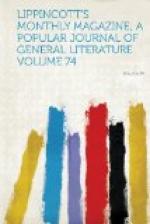The cabs of Paris, as a rule, are comparatively neat and comfortable, those belonging to the Compagnie Generale des Voitures (of which institution more anon) being carefully brushed and cleaned every day. In winter a two-seated coupe lined with dark cloth or with leather, and drawn by a single horse, is the usual style of vehicle offered for the accommodation of the public. The price of such a vehicle is thirty cents for a “course” or single unbroken trip, which may be from one side of Paris to the other, or forty cents an hour. The coachman is bound by law to give the person engaging him a square ticket on which is printed his number and the exact amount of his fare: this last, however, being stated as varying under certain conditions and at certain hours, is apt to be rather puzzling to the inexperienced traveler, particularly if he or she be ignorant of French. Four-seated carriages are hard to find in winter: they are drawn by two horses, and the fare is ten cents more on the course and by the hour than that of the two-seated ones. In summer the coupes are replaced by light, open, four-seated carriages, with a hood and with leather curtains, to be used in case of rain; and they are really pleasant and comfortable vehicles. The horses do not differ much from the style of cab-horses known all over the world, being thin, shabby and dismal-looking animals as a general thing, though exceptions to the rule are not uncommon.
The cabmen of Paris form a distinct class, a separate society, composed of all sorts of elements—a turbulent, indocile, rebellious set of men, always in revolt against their employers and against the law, which holds them with an iron and inflexible grasp. Most of them are Communists, though many of them are men belonging to the higher classes of society, whom dissipation, extravagance or misfortune has driven to this mode of gaining a living. Thus, it is a well-known fact that the son of a distinguished




